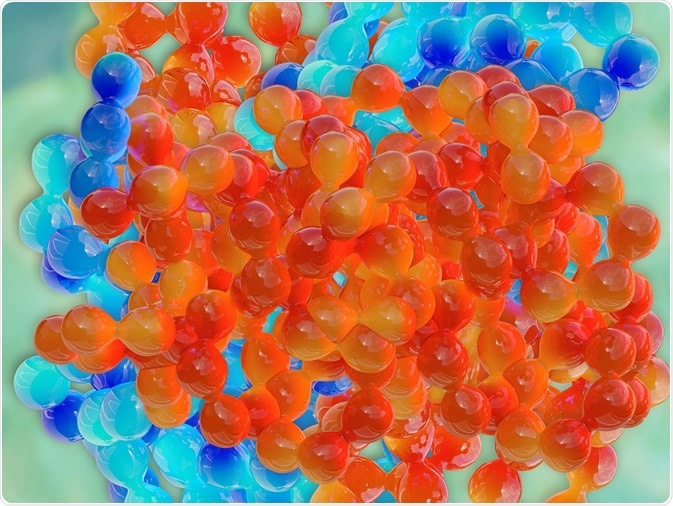Top-Down Approach in Proteomics

Proteomics is the large-scale study of proteins, allowing for greater understanding of final gene products.
 Credit: xrender/Shutterstock.com
Credit: xrender/Shutterstock.com
Proteoform is the term that defines all the molecular forms of a protein product occurring from a single gene. This description of variations in the same protein highlights the need for methods that analyze intact proteins.
The top-down approach to proteomics provides the advantage of proteoform mapping without loss of information. The methodology has important implications for the development of disease biomarkers and protein-based drugs.
Bottom-up versus top-down proteomics
Bottom-up proteomics have frequently been used in large-scale studies of proteins. The method is characterized by the chemical or enzymatic digestion of proteins before protein identification through mass spectrometry occurs.
The fragmentation-based detection of peptides allows for the original protein to be inferred. Though the technique produces high numbers of identifications, it is susceptible when peptides are not specific to one protein form.
The digestion process may remove large regions of the proteins which remain unidentified, preventing a full picture of the proteome from being formed. Furthermore, important details such as sequence variants are also lost, alongside their relationship to each other if modifications occur on separate peptides.
In top-down proteomics, intact proteins are introduced to the mass spectrometer where entire and fragmented ion masses are measured. Proteoforms are therefore mapped before degradation into fragment ions, supplying information on the whole state as well as the components that allow it to be identified.
Proteins no longer need to be assembled computationally from peptides in order to be identified. This provides the advantage of the full characterization of the proteoform, detecting details such as sequence variants and post-translational modifications.
Denatured and native modes of top-down proteomics
Denaturing top-down proteomics is most commonly employed and provides a high-powered technique for characterizing individual proteins of less than 30 kilodaltons. In contrast, the native mode of top-down proteomics has the advantage of being able to analyze highly purified multiproteome complexes that are larger than 100 kilodaltons in size.
Native mass spectrometry is a gas-phase method, which utilizes an electrospray to transform the analyte into the gas phase before fragmentation occurs through mass spectrometry. Both modes were compared in a 2016 study for mapping the protein complexes of King Cobra venom to increase understanding of the biomolecular complexes that are associated with venom lethality.
Denaturing top-down proteomics has limited application in venom studies because of the difficulty in providing analysis of intact proteins greater than 50 kilodaltons when protein concentrations in venom are lower than 0.5%.
The native mode was the most efficient method for analyzing the largest proteins present in the venom whilst preserving the macromolecular interactions between toxins. The ability to analyze whole protein complexes indicates that native mass spectrometry has promise for the development of future top-down proteomics technologies.
Applications of top-down proteomics
An early application of top-down proteomics was in the field of microbiology. Organism specific proteoforms have been analyzed to increase the speed of microorganism identification.
The technology has been utilized in the production of new biomarkers for detecting disease in its early stages. This is because the development of disease is dependent on the operation of functional proteoforms in their natural context, with top-down proteomics providing the level of detail required whilst surpassing peptide based methods.
Top-down proteomics is also being used in the development of protein-based drugs. Protein therapeutics, which includes monoclonal antibodies, have molecular weights greater than 100 kilodaltons. Therefore, the ability to map proteome complexes that are larger than 100 kilodaltons through native mass spectrometry will aid drug development.
Moreover, the top-down approach will be useful for the testing of a drug as a whole as well as its molecular components. Protein-based drugs can revolutionize therapeutics through specific targeting which will reduce treatment side effects.
Sources:
- Tran, J.C. et al. 2011. Mapping Intact Protein Isoforms in Discovery Mode Using Top Down Proteomics, Nature, 480, pp. 254-258.
- Catherman, A.D. et al. 2014. Top Down Proteomics: Facts and Perspectives, Biochemical and Biophysical Research Communications , 21, pp. 683-693.
- Melani, R.D. et al. 2016. Mapping Proteoforms and Protein Complexes From King Cobra Venom Using Both Denaturing and Native Top-down Proteomics, Molecular and Cellular Proteomics, 15, pp. 2423-2434.
- Toby, T.K. et al. 2016. Progress in Top-Down Proteomics and the Analysis of Proteoforms, Annual Review of Analytical Chemistry, 9, pp. 499-519.
Further Reading
- All Mass Spectrometry Content
- What is Mass Spectrometry?
- Mass Spectrometry Applications?
- Using Mass Spectrometry for Protein Complex Analysis
- Coupling and Ionization in Miniature Mass Spectrometry
Last Updated: Feb 26, 2019

Written by
Shelley Farrar Stoakes
Shelley has a Master's degree in Human Evolution from the University of Liverpool and is currently working on her Ph.D, researching comparative primate and human skeletal anatomy. She is passionate about science communication with a particular focus on reporting the latest science news and discoveries to a broad audience. Outside of her research and science writing, Shelley enjoys reading, discovering new bands in her home city and going on long dog walks.
Source: Read Full Article